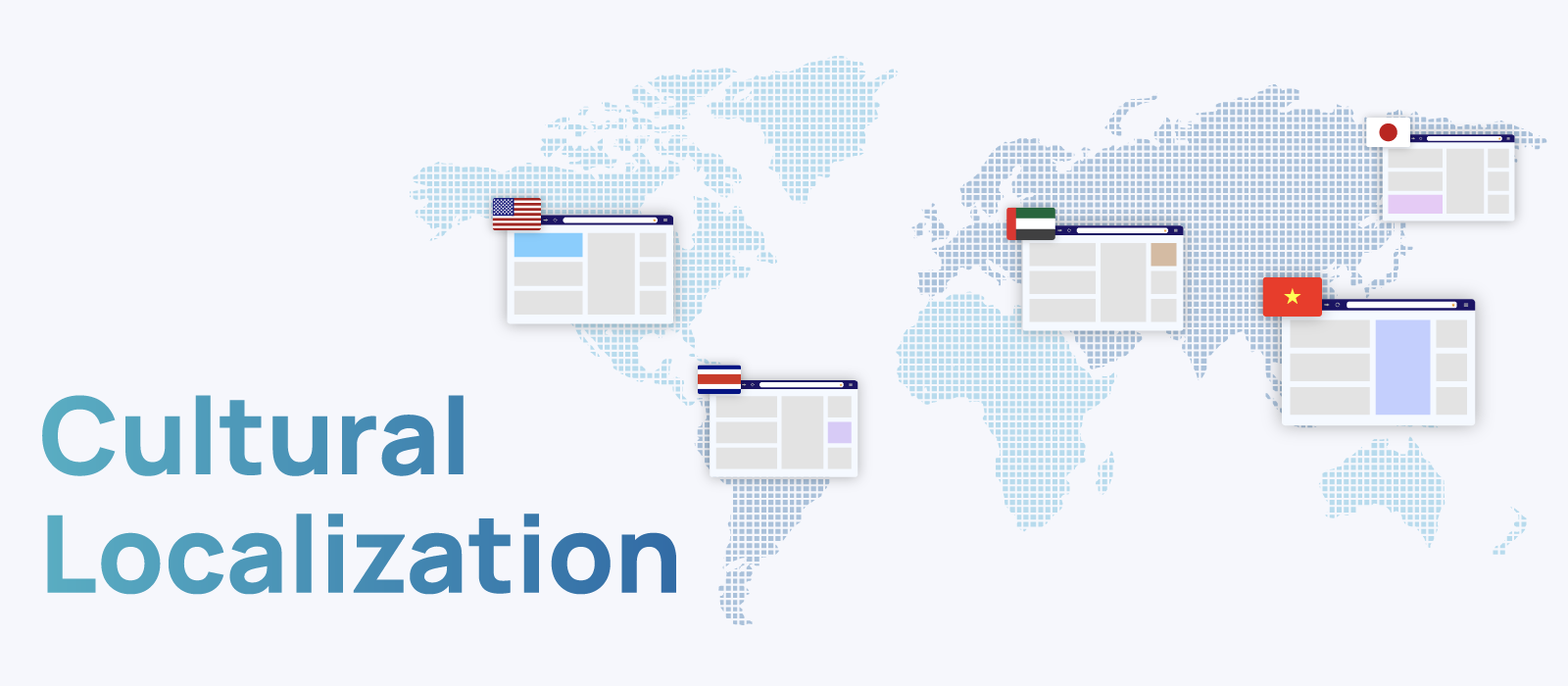UX UI Design Studio


Individuals from different cultural backgrounds behave and perceive differently, and this has a significant impact on designs. An excellent website/app design in a specific region might not work well elsewhere. Failing to localize websites/apps with cultural nuances can lead to a mismatch with the cultural context, potentially causing negative user satisfaction.
In this blog, Lollypop Design Studio will delve into the popular theory of Hofstede to explore different aspects of culture and its influences on website and app localization. Let’s explore together!
If you are curious about culture localization, and willing to discover the relationship between culture and design, this blog is a valuable resource for you!
According to Esselink (2003), localization is the process of combining language and technology to create a product that can effectively overcome cultural and language barriers. In the era of digitalization, website / app localization (or cultural localization) involves catering a product or platform for a specific region based on various cultural factors such as language, symbols, graphics, content, and color (Yalcin et al., 2011).
This is why it is crucial to have an understanding of cultural differences between countries to successfully localize a new product design when entering a new market.
To understand the influence of culture on design, we first delve into the realm of cultural dimensions theory by Hofstede (1980). This theory offers valuable insights into the variations in cultural values across different countries through 6 cultural dimensions.
Furthermore, we draw upon a study conducted by Marcus et al. (2000) that investigates the influence of Hofstede’s 6 cultural dimensions on the design of user interfaces. By synthesizing these sources, we can gain a deeper understanding of how cultural factors impact web and app localization process. Let’s explore as follows:
The power distance index in Hofstede’s cultural dimensions theory measures the level of acceptance and tolerance towards inequality and hierarchical power within a culture.
The dimension of individualism vs. collectivism examines the degree to which societies are integrated into groups and their perceived obligations and interdependence within those groups.
The dimension of femininity vs. masculinity, also known as gender role differentiation, examines the extent to which a society values traditional masculine and feminine roles.
The uncertainty avoidance dimension of Hofstede’s cultural dimensions examines a society’s willingness to tolerate uncertainty and ambiguity. In simple terms, uncertainty avoidance refers to how much a culture perceives change as threatening (Hofstede, 1980).
High uncertainty avoidance index
A high uncertainty avoidance index indicates a low tolerance for uncertainty, ambiguity, and risk-taking. Individuals within these cultures often display more emotional responses to changes.
When creating a localized version of an app or website, designers should prioritize simplicity by offering limited content and choices. The navigation should be straightforward and intuitive, with menus and hierarchies that provide a clear path for users to find the desired content.
Low uncertainty avoidance index
A low uncertainty avoidance index indicates a high tolerance for uncertainty and ambiguity. Individuals in these cultures feel comfortable in unstructured/ changeable environments and prefer to have as few rules as possible.
Designs for this culture can be more complex with maximal content. The navigation can be more flexible, allowing users to discover content in a non-linear manner. The design can incorporate elements that promote customization and personalization, empowering users to adapt the app to their individual preferences.
The dimension of long-term and short-term orientation in Hofstede’s cultural dimensions refers to how cultures encourage either delayed gratification or the immediate fulfillment of material or emotional needs.
The dimension of indulgence vs. restraint examines the extent to which a society fulfills its desires and controls its impulses.
Note: To determine cultural orientations of a specific country, you can refer to the Hofstede Insights website for the respective country’s Hofstede scores.
To explore the influence of Power Distance on regional design differences, we examine two university website designs from Malaysia and Australia. Firstly, let’s look at the website of Universiti Malaya, which belongs to Malaysia with a high Power Distance Index (PDI = 100). The homepage prominently displays the university’s regional ranking, emphasizing its expertise and authority.
On the other hand, we have the University of Melbourne, located in an Australian environment with a low Power Distance Index (PDI = 38). Its website showcases a more approachable aesthetic, featuring images of students and a clear call to action inviting freshers to study with them.
To illustrate the contrast between Masculinity and Femininity in website / app localization, we examine gym websites from the USA and Netherlands.
In a highly masculine culture like in the USA (MAS = 62), the homepages of gym websites commonly emphasize individual strength and encourage visitors to join the gym to achieve a chiseled physique to become an alpha. The focus is placed on attaining social status through physical prowess.
In contrast, gym websites in the feminine-oriented Netherlands (MAS = 14) adopt a different approach. They prioritize well-being and collaboration, often showcasing images of a team engaging in workouts together. The emphasis lies on improving one’s quality of life rather than gaining social status.
To exemplify the influence of Uncertainty Avoidance website / app localization, we can refer to a blog post by Jenny Shen that discusses her findings on the reasons why German users, compared to Dutch users, were less successful in booking travel deals on the booking platform “TravelBird”.
Initially, the first step in the checkout process is the same for both the German and Dutch versions (left image). However, considering the Uncertainty Avoidance Index, the Netherlands has an average UA score of 53, indicating a general comfort level with making purchases without exhaustive information. This helps explain why the user interface works well in this market.
On the other hand, Germany is characterized by a high Uncertainty Avoidance (UA = 65) culture, where individuals seek more reassurance before finalizing a booking. Therefore, when TravelBird added a comprehensive list of information, including details about inclusives/exclusives and trust badges, to the German version platform, the travel deal bookings increased.
You may want to read more: 5 Reasons why UX Design in Asia Pacific Region should be prioritized
Understanding cultural dimensions is essential for creating digital products that resonate with the preferences and expectations of the local market. By delving into the cultural nuances of different countries, we can gain valuable insights that enable us to craft localized designs tailored to the needs of local users.
At Lollypop Design Studio, we specialize in market research, user research, user experience research, design, and development. If the APAC region is your next big move, our dedicated team based in Vietnam might be your ideal design partner. Our team possesses extensive knowledge of UX design culture and expertise in UX research methodologies. We are committed to deepening our understanding of UX design across different cultures, providing you with the best insights that will facilitate the creation of exceptional designs for your target market.
Don’t hesitate to contact us to schedule a free consultation and craft brilliance together!

